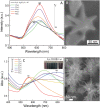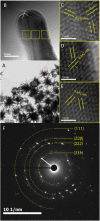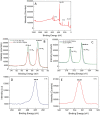Differences between surfactant-free Au@Ag and CTAB-stabilized Au@Ag star-like nanoparticles in the preparation of nanoarrays to improve their surface-enhanced Raman scattering (SERS) performance
- PMID: 37822906
- PMCID: PMC10563836
- DOI: 10.1039/d3na00483j
Differences between surfactant-free Au@Ag and CTAB-stabilized Au@Ag star-like nanoparticles in the preparation of nanoarrays to improve their surface-enhanced Raman scattering (SERS) performance
Abstract
In this study, we assessed the controlled synthesis and efficacy of surface-enhanced Raman scattering (SERS) on two distinct types of star-like Au@Ag core-shell nanoarrays. These nanoarrays were designed based on gold nanostars (AuNSs), which were synthesized with and without CTAB surfactant (AuNSs-CTAB and AuNSs-FS, respectively). The AuNS-FS nanoparticles were synthesized via a novel modification process, which helped overcome the previous limitations in the free-surfactant preparation of AuNSs by significantly increasing the number of branches, increasing the sharpness of the branches and minimizing the adsorption of the surfactant on the surface of AuNSs. Furthermore, the differences in the size and morphology of these AuNSs in the created nanoarrays were studied. To create the nanoarrays, a three-step method was employed, which involved the controlled synthesis of gold nanostars, covering them with a silver layer (AuNSs-FS@Ag and AuNSs-CTAB@Ag), and finally self-assembling the AuNS@Ag core-shelled nanoparticles via the liquid/liquid self-assembly method. AuNSs-FS@Ag showed higher ability in forming self-assembled nanoarrays than the nanoparticles prepared using CTAB, which can be attributed to the decrease in the repulsion between the nanoparticles at the interface. The nano-substrates developed with AuNSs-FS@Ag possessed numerous "hot spots" on their surface, resulting in a highly effective SERS performance. AuNSs-FS featured a significantly higher number of sharp branches than AuNSs-CTAB, making it the better choice for creating nanoarrays. It is worth mentioning that AuNSs-CTAB did not exhibit the same benefits as AuNSs-FS. The morphology of AuNSs with numerous branches was formed by controlling the seed boiling temperature and adding a specific amount of silver ions. To compare the SERS activity between the as-prepared nano-substrates, i.e., AuNS-CTAB@Ag and AuNS-FS@Ag self-assembled nanoarrays, low concentrations of crystal violet aqueous solution were characterized. The results showed that the developed AuNSs-FS@Ag could detect CV at trace concentrations ranging from 1.0 ng mL-1 to 10 ng mL-1 with a limit of detection (LOD) of 0.45 ng mL-1 and limit of quantification (LOQ) of 1.38 ng mL-1. The nano-substrates remained stable for 42 days with a decrease in the intensity of the characteristic Raman peaks of CV by less than 7.0% after storage. Furthermore, the spiking method could detect trace amounts of CV in natural water from the Dong Nai River with concentrations as low as 1 to 100 ng mL-1, with an LOD of 6.07 ng mL-1 and LOQ of 18.4 ng mL-1. This method also displayed good reproducibility with an RSD value of 5.71%. To better understand the impact of CTAB stabilization of the Au@Ag star-like nanoparticles on their surface-enhanced Raman scattering (SERS) performance, we conducted density functional theory (DFT) calculations. Our research showed that the preparation of AuNSs-FS@Ag via self-assembly is an efficient, simple, and fast process, which can be easily performed in any laboratory. Furthermore, the research and development results presented herein on nanoarrays have potential application in analyzing and determining trace amounts of organic compounds in textile dyeing wastewater.
This journal is © The Royal Society of Chemistry.
Conflict of interest statement
There are no conflicts to declare.
Figures















Similar articles
-
Gold nanostars: Benzyldimethylammonium chloride-assisted synthesis, plasmon tuning, SERS and catalytic activity.J Colloid Interface Sci. 2016 Jan 15;462:341-50. doi: 10.1016/j.jcis.2015.10.007. Epub 2015 Oct 9. J Colloid Interface Sci. 2016. PMID: 26476203
-
Facile tuning of tip sharpness on gold nanostars by the controlled seed-growth method and coating with a silver shell for detection of thiram using surface enhanced Raman spectroscopy (SERS).RSC Adv. 2022 Aug 15;12(35):22815-22825. doi: 10.1039/d2ra03396h. eCollection 2022 Aug 10. RSC Adv. 2022. PMID: 36105964 Free PMC article.
-
Ag-coated Au nanostar-based Lateral Flow Immunoassay for Highly Sensitive Influenza A virus antibody Detection in Colorimetric and Surface-Enhanced Raman Scattering (SERS) modes.Talanta. 2025 Apr 1;285:127351. doi: 10.1016/j.talanta.2024.127351. Epub 2024 Dec 6. Talanta. 2025. PMID: 39657522
-
Role of Surface Curvature in Gold Nanostar Properties and Applications.ACS Biomater Sci Eng. 2024 Jan 8;10(1):38-50. doi: 10.1021/acsbiomaterials.3c00249. Epub 2023 May 30. ACS Biomater Sci Eng. 2024. PMID: 37249042 Review.
-
Recent advances of Au@Ag core-shell SERS-based biosensors.Exploration (Beijing). 2023 Feb 7;3(1):20220072. doi: 10.1002/EXP.20220072. eCollection 2023 Feb. Exploration (Beijing). 2023. PMID: 37323623 Free PMC article. Review.
Cited by
-
Recent Progress on the Application of Microneedles for In Situ Sampling in Surface-Enhanced Raman Scattering Detection.Biosensors (Basel). 2025 Jun 1;15(6):350. doi: 10.3390/bios15060350. Biosensors (Basel). 2025. PMID: 40558432 Free PMC article. Review.
References
-
- Sooraj K. P. Ranjan M. Rao R. Mukherjee S. Appl. Surf. Sci. 2018;447:576–581. doi: 10.1016/j.apsusc.2018.04.020. - DOI
-
- Liang X. Li N. Zhang R. Yin P. Zhang C. Yang N. Liang K. Kong B. NPG Asia Mater. 2021;13:8. doi: 10.1038/s41427-020-00278-5. - DOI
-
- Sharma B. Frontiera R. R. Henry A.-I. Ringe E. Van Duyne R. P. Mater. Today. 2012;15:16–25. doi: 10.1016/S1369-7021(12)70017-2. - DOI
LinkOut - more resources
Full Text Sources
Miscellaneous

